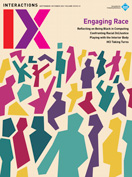Authors:
Christina Harrington, Daniela Rosner, Alex Taylor, Mikael Wiberg
How is HCI engaging with the topic of race? The past year has seen a broadened attention to this question. Black scholars in HCI and computing have called for accountability around racial equity and access not only in our research but also in our methods of publishing, conference spaces, and leadership. Critical race theory scholars have posed important questions related to the field's quick-to-fix sensibility. And the sustaining of structural white supremacy in the field's content and bureaucracy has provoked urgent remedial actions—panels, trainings, roundtables, even the occasional fellowship.
While immediate actions are useful and important, the contributions to this conversation in this issue of Interactions probe deeper. In this issue, we feature articles from scholars who ask us to go beyond just considering race in the technicalities of HCI. They point out that urgency alone is insufficient. A true concern for racial justice and equity must involve continuous work and commitment, especially from allies. It also demands long-term, structural changes. In this commitment, we must propose a certain refusal—a refusal to treat race or racial injustice as a "problem" to solve and instead look to the fullness of alternative possibilities. These contributions show how the HCI field might learn from the joy infused in calls for love (bell hooks) and the reconciliatory reckonings in calls for sitting with paradoxical and irreconcilable pain (Saidiya Hartman). They remind HCI scholars of the need for slowness and deliberateness alongside immediacy.
In this issue, we feature articles from scholars who ask us to go beyond just considering race in the technicalities of HCI.
Many of us in HCI try to build more equitable, antiracist futures with tools that emerge from and thus reproduce the same systems of racial inequity. In many instances, our approach to design perpetuates its own form of harm and our solutions reproduce the problems. They foreground the rise of what Ruha Benjamin calls the New Jim Code, Meredith Broussard names technochauvinism, and Safiya Umoja Noble terms algorithms of oppression. Transcending this harmful cycle might mean working outside it. It might require embracing radical traditions of resilience, truth, collective vulnerability, and care already in our midst. Christina Harrington, quoting Tarana Burke, calls this process one of giving our humanity breathing room—embracing the already thriving worlds within a life otherwise.
We welcome you to the Interactions issue on engaging race. Throughout this issue you will find reflections and calls to action by HCI scholars who ask us to consider how the field of HCI addresses topics of social justice and beyond-surface inclusivity. We invite readers to do their own reflection and checkins with design and research teams to move toward a more equitable and just practice of interaction design.
Christina Harrington (guest editor), Daniela Rosner, Alex Taylor, Mikael Wiberg [email protected]
Copyright held by authors
The Digital Library is published by the Association for Computing Machinery. Copyright © 2021 ACM, Inc.








Post Comment
No Comments Found